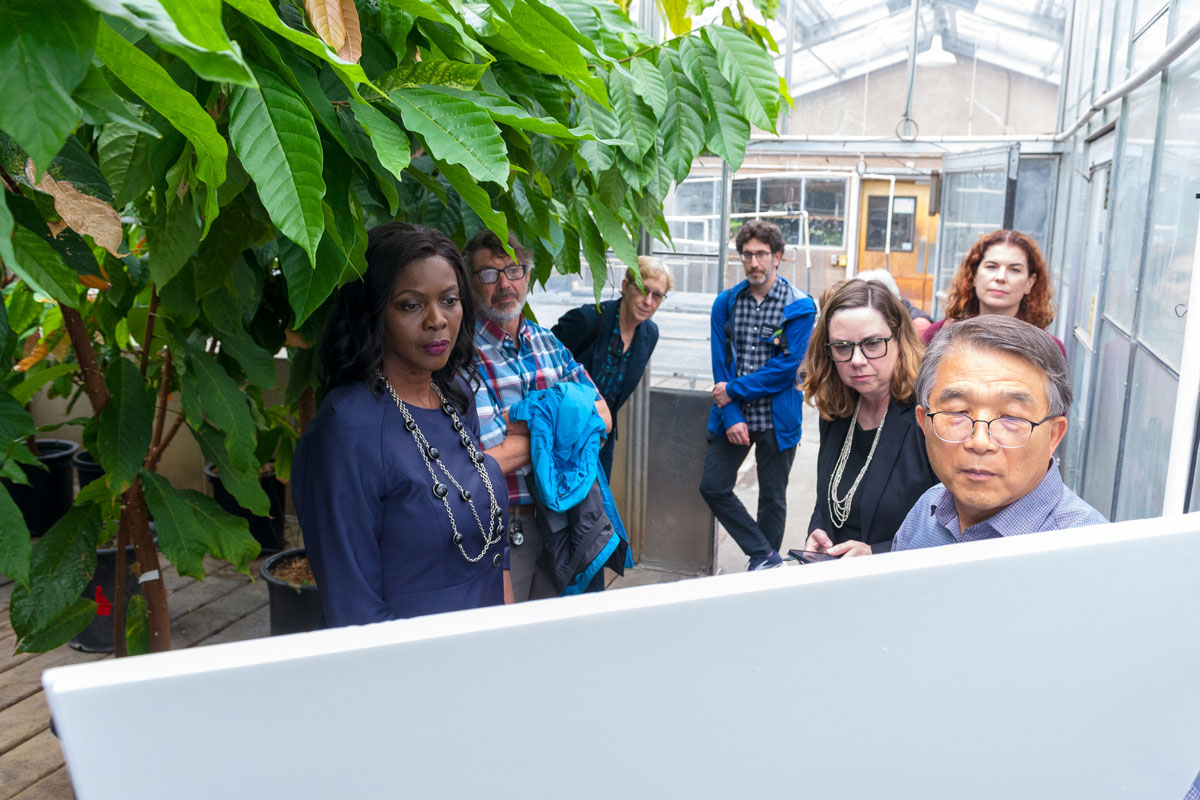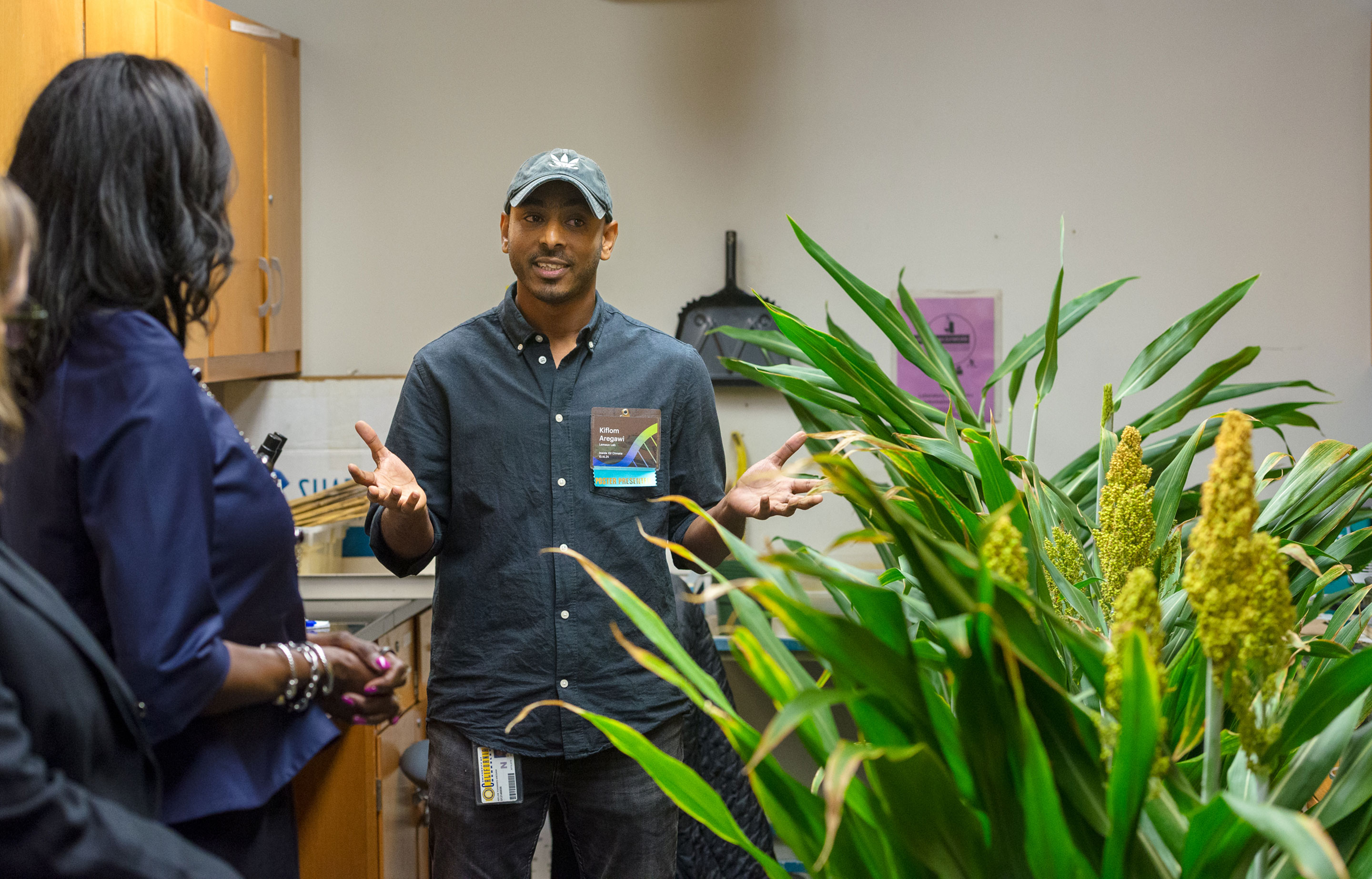
[image caption]
USDA Under Secretary Jacobs-Young Tours Oxford Facility
As part of a visit to campus last week, Rausser College of Natural Resources was honored to host Dr. Chavonda Jacobs-Young, USDA Under Secretary for Research, Education, and Economics and USDA's Chief Scientist, for a visit at the UC Berkeley’s Oxford Facility.
Located on the northwest side of the Berkeley campus, the Oxford Facility provides specialized plant growth facilities, an insectary, field space, services, and expertise to support the University’s plant science research and teaching needs. The Oxford Facility has long served as a core research infrastructure supporting Rausser College’s role as an Agricultural Experiment Station, along with counterparts at UC Davis, Riverside, Santa Cruz, and Merced.

[image caption]
After attending a Climate Summit held at the Innovative Genomics Institute, the Under Secretary was able to join Rausser College for a tour of the Oxford Facility’s greenhouse and field space, during which she heard from graduate students, researchers, and early-career faculty about various research projects being conducted there.
“Students, staff and faculty were able to show the Under Secretary their cutting edge research on agriculture and plant science. These projects are examples of the kinds of efforts needed to develop sustainable, productive agricultural systems of the future,” said Dennis Baldocchi, Rausser College’s Executive Associate Dean Baldocchi is also the College’s Director of Agriculture and Natural Resource Programs, a role that involves serving as the UC Berkeley representative to UC's Agricultural and Natural Resources (ANR) Program Council, which advises the Vice-President of ANR. “This work can only flourish with proper facilities and equipment. Support and updates for the Oxford Facility will be instrumental in ensuring their continuation and success,” Baldocchi added. “Because many agricultural research facilities supported by USDA are suffering from deferred maintenance, this visit by the Under Secretary was timely and allowed us to show her the state of our facilities.”
“Fortifying agriculture's scientific infrastructure at colleges, universities and federal facilities across the nation is critical for the future of food, fiber and fuel,” said Jacobs-Young. “Our world-class scientists deserve well-equipped, modernized buildings and equipment to tackle our biggest challenges, protect our food supply, and keep innovating at the pace that has historically given us all an abundant, safe and nutritious food supply.”
During the tour, the group visited six stations. Myeong-Je Cho, director and principal investigator of the Innovative Genomics Institute’s Plant Genomics Transformation Facility, discussed his group’s work on cacao transformation and gene editing for disease resistance in cacao plants. He noted that major portions of the world’s cacao—crucial for the production of chocolate—are grown in areas that are severely impacted by the stressors of climate change. When factoring in the impact of untreatable diseases like black pod disease and cacao swollen shoot virus (CSSV), cacao production worldwide is expected to drop by 11% this year alone. Cho outlined his group’s CRISPR-based genome-editing and genetic transformation strategies being explored for their potential to make cacao plants with more robust immune systems and increased resistance to infections.
Patricia Lang, an assistant professor in the Department of Plant and Microbial Biology, discussed her work studying how plants respond to climate change. Currently focusing on the model plant Arabidopsis, Lang’s lab combines bioinformatics and molecular biology and utilizes historical collections to understand how and why plants are flowering earlier than they used to. They identify historical changes and then re-engineer them and “de-extinct” them into plants to test their effects on a phenotype in the greenhouse and under simulated climate change conditions, both past, present, and future.

[image caption]
Researcher Katerina Estera-Molina explained research going on in the Environmental Plant Isotope Chamber Dynamic Ecosystem Labeling Facility. Chambers in the facility are used to verify and quantify agricultural crops being developed for climate change mitigation. They can control carbon dioxide and methane conditions in growing chambers and later measure how much carbon ends up in the soil, the microbes, and the plants themselves, thus quantifying if the developed plants are “doing better” than their “wild type.” Estera-Molina, who is a project manager in the labs of Jennifer Pett-Ridge and Professor Mary Firestone, highlighted an IGI project involving growing different rice genotypes with the intent of elongating plant roots to potentially store carbon in the ground.
Kiflom Aregawi, a research associate in the lab of Cooperative Extension Professor Peggy Lemaux, discussed their group’s research on sorghum, a crop that originated in East Africa and is known for its resilience to drought, flooding, and high temperatures. The crop is used for food for both humans and animals, as well as for bioenergy. However, previous genome modification attempts on sorghum were not efficient—only 5% of plants were engineered. Recently, the group utilized new approaches to increase the engineering rate to 50% and the editing rate to 95%. With the new transformation and editing strategies Aregawi and others are exploring multiple target genes related to photosynthesis, root architecture, and root exudates—all plant traits related to potentially improving carbon sequestration capabilities.
Armen Kelikian, a graduate student working in the lab of Professor Krishna Niyogi in the Department of Plant and Microbial Biology, discussed their group’s work related to photosynthetic efficiency in rice and other crops. The group is specifically focused on photoprotection, which plants modulate as light conditions change. Using CRISPR-Cas9, the team was able to alter the regulatory sequences of three photoprotective genes, which resulted in plants being able to respond more rapidly to changing light conditions.

[image caption]
Miguel Ochoa, a graduate student working with Professor Timothy Bowles in the Department of Environmental Science, Policy, and Management, led the group to a research field outside the greenhouse buildings, one of two agricultural research sites at Berkeley. The other is the Gill Tract, three miles north of the main UC Berkeley campus. Both sites are open to student projects, and the Gill Tract is also home to a community farm. Ochoa’s doctoral research focuses on cover crops and soil health. Cover crops are not grown for commercial production but instead to conserve soil water and recycle nutrients back into soils. With support from a USDA-NIFA grant, Ochoa is leading a four-year trial to explore the tradeoffs involved in growing cover crops rather than commercial crops. Collaborators on the project include UC Santa Cruz researchers and thirty commercial partners.
Over lunch, leaders of the Berkeley Food Institute, including Faculty Directors Susana Matias and Isabel Madzorera, shared the Institute’s work bringing Berkeley food and farm systems research to policymakers and community partners through its outreach and education efforts as part of BFI’s mission to support sustainable and just food systems. Matias and Madzorera highlighted the Institute’s Farm to School Incubator Grant Program Evaluation, looking at farmer benefits and environmental impacts of the state’s program, among other policy-oriented research initiatives. They also discussed the evaluation of Senate Bill 1000, a city and county planning law in California aimed at improving local planning to incorporate environmental justice elements into General Plans, including how to improve food access.
For more information about research happening at the Oxford Facility, visit the Facility news page.
